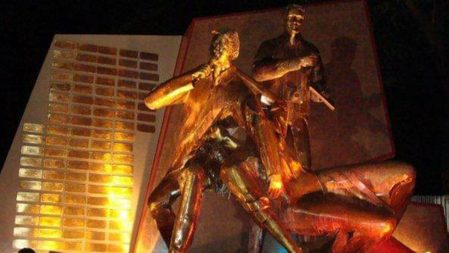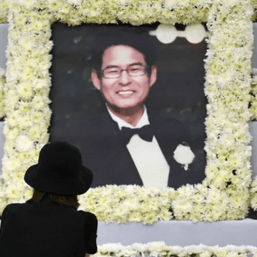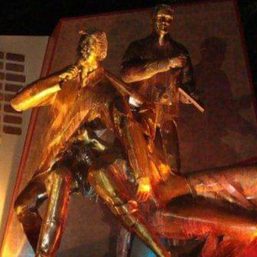SUMMARY
This is AI generated summarization, which may have errors. For context, always refer to the full article.

CAGAYAN DE ORO CITY, Philippines – Juan “Johnny Walker” Jumalon, the broadcaster whose murder was inadvertently livestreamed, was more of an entertainer than a newsman or commentator. He was known for bringing morning entertainment and good vibes to his radio listeners in Misamis Occidental.
Jumalon’s 5:30 am radio show, Pahapyod sa Kabuntagon (Rubbing Touch in the Morning), was the curtain raiser of 94.7 Gold FM Calamba, a small five-kilowatt radio station he operated adjacent to his home in Calamba town, Misamis Occidental.
He referred to himself and his fellow program hosts at the radio station as DJs or disc jockeys, distinguishing them from traditional radio anchormen or commentators, similar to the distinction made for FM station program hosts in years past.
The 57-year-old Jumalon was known as a funny man who cracked jokes on air while Yoyoy Villame- and Max Surban-style novelty songs played in the background.
But he was also a politician who vied for a town council seat in Calamba in 2022, under the Asenso Pinoy banner. He came close, securing the ninth spot in the race for town council seats.
His widow, Cherebel, said Jumalon didn’t speak ill of anyone on air or even when he campaigned for a town council seat, a position he held in 2013. He served as a town legislator for one term, or for three years, a decade ago.
His show focused more on greeting people and playing music than on news and commentary, according to Manny Francis Ronquillo of DXDD 657, an AM radio station of Dan-ag sa Dakbayan Broadcasting Corporation.
Jumalon, a fast talker on air, endeared himself to his community, where his voice reverberated each morning by greeting people and mentioning their names during his broadcasts.
One of his avid listeners, Marian Ponce, paid tribute on his Facebook page: “Magpabilin kang buhi sa among dughan… Dili ka namo malimtan. Wla nay mosibya sa among ngalan saka hanginan wla nay mgpasiaw saka hanginan.”
(You will remain alive in our hearts…. We will not forget you. No one will broadcast our names or tell jokes on air anymore.)
Veteran broadcaster Expedita “Thata” Roxas, president of the Misamis Occidental Press Corps, described Jumalon as good-natured.
She said Jumalon was at a disadvantage even if he had the chance to defend himself when he was attacked last Sunday because he was a person with a disability (PWD) who used crutches to walk.
Chilling effect
Jumalon’s brutal killing, inadvertently broadcast by his radio station and livestreamed on Facebook on Sunday, November 5, horrified his radio audience and netizens, and produced a chilling effect on media workers in Misamis Occidental, including Ozamiz City, where there are at least 10 radio stations operating across the province.
“Ampo lang ta. Siyempre kulbaan ta (Let’s just pray. Of course, we feel unsafe),” Ronquillo said.
The national board of the Kapisanan ng mga Brodkaster ng Pilipinas (KBP) condemned the fatal shooting of Jumalon, saying the “incident shows the utter disregard for human life and the rule of law by the perpetrator.”
The KBP said Jumalon’s radio station was not a member of the organization, but “we denounce the crime.”
The organization also said that it saw Jumalon’s murder as “an attack against the media community and a grave threat to press freedom and the safety of citizens in the community because it was committed so brazenly and with impunity.”
Problems with NTC
Jumalon had not applied for membership with the KBP in Misamis Occidental, and he encountered problems with the National Telecommunications Commission (NTC).
The NTC, the regulatory agency responsible for overseeing and regulating the broadcast industry, had issued two cease-and-desist orders against Jumalon’s radio station because it was using two FM frequencies – 94.5 megahertz and 94.7 MHz – that were not assigned to it.
Neither did the radio station have a provisional authority from the NTC.
NTC Northern Mindanao Director Teodoro Buenavista Jr. said on Monday, November 6, that Jumalon was using 94.5 MHz under Kalayaan Broadcasting System’s franchise and 94.7 MHz under Sagay Broadcasting Corporation. Both were recently traced to the same locations in Calamba, Misamis Occidental.
He said the NTC was unaware of Gold FM Calamba’s broadcasting and the location of its network until Jumalon’s gruesome killing on Sunday morning.
Buenavista, however, said Jumalon had a pending petition for a provisional authority to operate, asserting that Gold FM Calamba is an affiliate of a franchise-holder, Kalayaan Broadcasting System, owned by the Davao City-based Anflo Management and Investment Corporation.
He said the NTC was checking Jumalon’s claim because 94.7 MHz was assigned to Radio Television Network Incorporated of Ozamiz City-based Misamis Institute of Technology (MIT).
MIT established a television station in 1987 that was then affiliated with GMA-7 and later with ABS-CBN until 2017.
According to Buenavista, Jumalon claimed to be an heir of MIT’s owners. – Rappler.com
Add a comment
How does this make you feel?




















There are no comments yet. Add your comment to start the conversation.